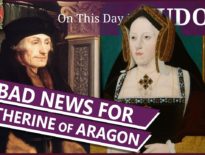This day in Tudor history, 9th November 1569, is the traditional date given for the start of the only major armed rebellion of Elizabeth I’s reign. It’s known as The Northern Rebellion or Rising of the North or Revolt of the Northern Earls.
Northern earls Charles Neville, 6th Earl of Westmorland and Thomas Percy, 7th Earl of Northumberland, led this uprising against Elizabeth I, seeking to depose her, replace her with Mary, Queen of Scots, and restore Catholicism.
But what happened?
Find out about the 1569 Northern Rebellion and the fate of the Northern Earls in today's talk.
Also on this day in Tudor history, 9th November 1518, Queen Catherine of Aragon, Henry VIII’s wife of nine years, gave birth prematurely to a stillborn daughter at Greenwich Palace. This was to be Catherine's sixth and final pregnancy. She had tried her very best to give King Henry VIII what he wanted, a surviving son and heir, a Prince of Wales. In last year’s video, I explained what happened on this day in 1518 and what we know about Queen Catherine of Aragon's pregnancies.
Also on this day in history:
- 1593 – Death of William Harris, historian and topographer, at St George's Chapel, Windsor. He was buried in the chapel. Harris's works included “Historicall Description of the Island of Britain” and “The Great English Chronology”.
- 1596 – Burial of George Peele, poet and playwright, at St James's Clerkenwell. His plays included “The Arraignment of Paris”, “Edward I”, “The Battle of Alcazar”, “The Old Wives' Tale” and “The Love of King David and fair Bethsabe”.
- 1623 – Death of William Camden, Richmond Herald, antiquary, historian, topographer and officer of arms, at Chislehurst in Kent. He was aged seventy-three. He was buried in the south aisle of Westminster Abbey. Camden is known for his “Britannia”, which was the first chorographical survey of Great Britain and Ireland, and his Annales Rerum Gestarum Angliae et Hiberniae Regnate Elizabetha, his history of Elizabeth I's reign.
Transcript:
This day in Tudor history, 9th November 1569, is the traditional date given for the start of the only major armed rebellion of Elizabeth I’s reign. It’s known as The Northern Rebellion or Rising of the North or Revolt of the Northern Earls.
Let me tell you a bit more about this Elizabethan rebellion…
In November 1569, Elizabeth I had been on the throne for 11 years, having succeeded her Catholic half-sister, Mary I. Both women had been made illegitimate by King Henry VIII, but some Catholics who opposed Elizabeth’s religious settlement, which re-established the Church of England’s independence from Rome, confirmed Elizabeth’s status as supreme governor of the church, and reintroduced the Book of Common Prayer, viewed Elizabeth I as illegitimate and looked to the Catholic Mary, Queen of Scots, as an alternative. Mary had been forced to abdicate as Queen of Scotland in 1567, in favour of her son, who became King James VI, and she had fled to England, arriving in 1568, hoping for protection and help to regain the Scottish crown. However, Mary was surrounded by suspicion, with some believing that she had been involved in her second husband Lord Darnley’s murder, and Elizabeth I ordered her to be taken into protective custody.
In the meantime, a number of powerful Northern lords who were unhappy with Elizabeth’s religious changes, were also unhappy with how Elizabeth was limiting their powers with her policy of centralization, that is to say, shifting power from regions to central government, a policy that her father had started. Protestants were also being appointed to important offices in the North.
By November 1569, key Northern earls, such as Charles Neville, 6th Earl of Westmorland and Thomas Percy, 7th Earl of Northumberland, had had enough of the situation and began gathering troops. Their aim was to depose Elizabeth I replace her with Mary, Queen of Scots, who would marry Thomas Howard, 4th Duke of Norfolk, and restore Catholicism as the country’s faith.
With troops numbering over 4,500 men, they rode to Durham where they stormed the cathedral and set about destroying the English Bible and communion table. This was the cathedral of James Pilkington, Bishop of Durham, a staunch Protestant who’d had disagreements with both earls regarding his handling of recusancy in his diocese and his policies in the area. The rebels celebrated an illegal Catholic mass in the cathedral and masses were said in a number of other churches in Durham, Darlington, Richmond, Northallerton and Ripon.
By 29th November, the rebels who’d turned south hopeful of raising more support, had reached Bramham Moor near Wetherby and numbered 4,000 foot soldiers and a further 1,700 on horseback. However, the Earl of Sussex, was marching towards them from York with a force of around 7,000 men, and the Earl of Warwick and Lord Admiral Clinton were also on their way with around 12,000 men. The rebels reacted by breaking up, with Northumberland taking some troops to his seat, Alnwick Castle, some heading to Hartlepool, which they took, to wait for assistance due to come from the Continent, and Westmoreland marching on Streatham Castle, which he took, and then also taking Barney Castle. Their success was shortlived though. As Sussex’s troops arrived in the area, the rebels dispersed and attempted to flee, retreating North.
Many were captured and an estimated 600 to 800 rebels were executed. Northumberland and Westmoreland fled to Scotland. Westmoreland managed to evade capture and execution by escaping to Flanders where he lived in exile until his death in 1601, but Northumberland was handed over to England and executed at York on 22nd August 1572. He was beatified in 1895 by Pope Leo XIII.



One branch, the Clarke family, of my family tree starts in 1600 at Ulley Hall, North Yorkshire. Is there any connection between the family starting and The Northern Rebellion or Rising of the North or Revolt of the Northern Earls? Any help to claify this matter would be gratefully received.